The Analysis of North Brazil Current Rings from Automatic Identification System Data and Altimetric Currents
Abstract
:1. Introduction
2. Data
2.1. AVISO/DUACS
2.2. AIS
2.3. Assessment of AIS and AVISO Ocean Current Estimates against In Situ Datasets
2.4. The EUREC4 A-OA Measurements
2.5. Numerical Model
3. Eddy Detection and Tracking Method
4. Results
4.1. Eddy Tracking Statistics
4.2. Individual NBC Ring Tracking
4.2.1. Statistics of Physical NBC Characteristics Derived from AIS and Satellite Altimetry Data
- Translation speed
- Rmax
- Vmax
- Ro
4.2.2. Temporal Variability of Physical NBC Characteristics Derived from AIS and Satellite Altimetry Data
4.3. Spatio-Temporal Variability of the NBC Ring as Derived from AMEDA
5. Discussion
6. Conclusions
Author Contributions
Funding
Data Availability Statement
Acknowledgments
Conflicts of Interest
Abbreviations
| AMEDA | Angular Momentum Eddy Detection and tracking Algorithm |
| AMOC | Atlantic Meridional Overturning Circulation |
| AVISO | Archiving, Validation and Interpretation of Satellite Oceanographic Data |
| CLS | Collecte Localisation Satellites |
| CMEMS | European Copernicus Marine Environment Monitoring Service |
| NBC | North Brazil Current |
| NEC | North Equatorial Current |
| SEC | South Equatorial Current |
| SLA | Sea level anomaly |
| SSS | Sea surface salinity |
| SST | Sea surface temperature |
| WBC | Western boundary current |
| WTNA | Western Tropical North Atlantic ocean |
| IMO | International Maritime Organization |
References
- Cushman-Roisin, B.; Tang, B.; Chassignet, E.P. Westward motion of mesoscale eddies. J. Phys. Oceanogr. 1990, 20, 758–768. [Google Scholar] [CrossRef]
- Fratantoni, D.M.; Richardson, P.L. The evolution and demise of North Brazil Current rings. J. Phys. Oceanogr. 2006, 36, 1241–1264. [Google Scholar] [CrossRef]
- Johns, W.E.; Lee, T.N.; Schott, F.A.; Zantopp, R.J.; Evans, R.H. The North Brazil Current retroflection: Seasonal structure and eddy variability. J. Geophys. Res. Ocean. 1990, 95, 22103–22120. [Google Scholar] [CrossRef]
- Richardson, P.; Hufford, G.; Limeburner, R.; Brown, W. North Brazil current retroflection eddies. J. Geophys. Res. Ocean. 1994, 99, 5081–5093. [Google Scholar] [CrossRef]
- Fratantoni, D.M.; Johns, W.E.; Townsend, T.L. Rings of the North Brazil Current: Their structure and behavior inferred from observations and a numerical simulation. J. Geophys. Res. Ocean. 1995, 100, 10633–10654. [Google Scholar] [CrossRef]
- Garzoli, S.L.; Ffield, A.; Yao, Q. North Brazil Current rings and the variability in the latitude of retroflection. In Elsevier Oceanography Series; Elsevier: Amsterdam, The Netherlands, 2003; Volume 68, pp. 357–373. [Google Scholar]
- Sharma, N.; Anderson, S.P.; Brickley, P.; Nobre, C.; Cadwallader, M.L. Quantifying the seasonal and interannual variability of the formation and migration pattern of North Brazil Current Rings. In Proceedings of the OCEANS 2009, Bremen, Germany, 11–14 May 2009; pp. 1–7. [Google Scholar]
- Castelão, G.; Johns, W. Sea surface structure of North Brazil Current rings derived from shipboard and moored acoustic Doppler current profiler observations. J. Geophys. Res. Ocean. 2011, 116. [Google Scholar] [CrossRef]
- Garraffo, Z.D.; Johns, W.E.; Chassignet, E.P.; Goni, G.J. North Brazil Current rings and transport of southern waters in a high resolution numerical simulation of the North Atlantic. In Elsevier Oceanography Series; Elsevier: Amsterdam, The Netherlands, 2003; Volume 68, pp. 375–409. [Google Scholar]
- Jochumsen, K.; Rhein, M.; Hüttl-Kabus, S.; Böning, C.W. On the propagation and decay of North Brazil Current rings. J. Geophys. Res. Ocean. 2010, 115, C10004. [Google Scholar] [CrossRef]
- Didden, N.; Schott, F. Eddies in the North Brazil Current retroflection region observed by Geosat altimetry. J. Geophys. Res. Ocean. 1993, 98, 20121–20131. [Google Scholar] [CrossRef]
- Subirade, C.; L’Hégaret, P.; Speich, S.; Laxenaire, R.; Karstensen, J.; Carton, X. Combining an Eddy Detection Algorithm with In-Situ Measurements to Study North Brazil Current Rings. Remote Sens. 2023, 15, 1897. [Google Scholar] [CrossRef]
- Goni, G.J.; Johns, W.E. A census of North Brazil Current rings observed from TOPEX/POSEIDON altimetry: 1992–1998. Geophys. Res. Lett. 2001, 28, 1–4. [Google Scholar] [CrossRef]
- Fratantoni, D.M.; Glickson, D.A. North Brazil Current ring generation and evolution observed with SeaWiFS. J. Phys. Oceanogr. 2002, 32, 1058–1074. [Google Scholar] [CrossRef]
- Mélice, J.L.; Arnault, S. Investigation of the intra-annual variability of the North Equatorial Countercurrent/North Brazil Current eddies and of the instability waves of the North tropical Atlantic Ocean using satellite altimetry and Empirical Mode Decomposition. J. Atmos. Ocean. Technol. 2017, 34, 2295–2310. [Google Scholar] [CrossRef]
- Aroucha, L.; Veleda, D.; Lopes, F.; Tyaquiçã, P.; Lefèvre, N.; Araujo, M. Intra-and inter-annual variability of North Brazil current rings using angular momentum Eddy detection and tracking algorithm: Observations from 1993 to 2016. J. Geophys. Res. Ocean. 2020, 125, e2019JC015921. [Google Scholar] [CrossRef]
- Bueno, L.F.; Costa, V.S.; Mill, G.N.; Paiva, A.M. Volume and Heat Transports by North Brazil Current Rings. Front. Mar. Sci. 2022, 9, 831098. [Google Scholar] [CrossRef]
- Johns, W.E.; Zantopp, R.J.; Goni, G.J. Cross-gyre transport by North Brazil Current rings. In Elsevier Oceanography Series; Elsevier: Amsterdam, The Netherlands, 2003; Volume 68, pp. 411–441. [Google Scholar]
- Ffield, A. Amazon and Orinoco River plumes and NBC rings: Bystanders or participants in hurricane events? J. Clim. 2007, 20, 316–333. [Google Scholar] [CrossRef]
- Le Goff, C.; Boussidi, B.; Mironov, A.; Guichoux, Y.; Zhen, Y.; Tandeo, P.; Gueguen, S.; Chapron, B. Monitoring the greater Agulhas Current with AIS data information. J. Geophys. Res. Ocean. 2021, 126, e2021JC017228. [Google Scholar] [CrossRef]
- Stevens, B.; Bony, S.; Farrell, D.; Ament, F.; Blyth, A.; Fairall, C.; Karstensen, J.; Quinn, P.K.; Speich, S.; Acquistapace, C.; et al. EUREC4A. Earth Syst. Sci. Data 2021, 13, 4067–4119. [Google Scholar] [CrossRef]
- Guichoux, Y.; Lennon, M.; Thomas, N. Sea surface currents calculation using vessel tracking data. In Proceedings of the Maritime Knowledge Discovery and Anomaly Detection Workshop, Joint Research Centre, Ispra, Italy, 5–6 July 2016. [Google Scholar]
- Benaïchouche, S.; Legoff, C.; Guichoux, Y.; Rousseau, F.; Fablet, R. Unsupervised reconstruction of sea surface currents from ais maritime traffic data using trainable variational models. Remote Sens. 2021, 13, 3162. [Google Scholar] [CrossRef]
- Richardson, P.L.; McKee, T. Average seasonal variation of the Atlantic equatorial currents from historical ship drifts. J. Phys. Oceanogr. 1984, 14, 1226–1238. [Google Scholar] [CrossRef]
- Richardson, P.; Reverdin, G. Seasonal cycle of velocity in the Atlantic North Equatorial Countercurrent as measured by surface drifters, current meters, and ship drifts. J. Geophys. Res. Ocean. 1987, 92, 3691–3708. [Google Scholar] [CrossRef]
- Richardson, P.L. Drifting in the wind: Leeway error in shipdrift data. Deep. Sea Res. Part I Oceanogr. Res. Pap. 1997, 44, 1877–1903. [Google Scholar] [CrossRef]
- Brown, J. Ocean Circulation: Prepared by an Open University Course Team; Elsevier: Amsterdam, The Netherlands, 2016. [Google Scholar]
- Le Traon, P.; Nadal, F.; Ducet, N. An improved mapping method of multisatellite altimeter data. J. Atmos. Ocean. Technol. 1998, 15, 522–534. [Google Scholar] [CrossRef]
- Bretherton, F.P.; Davis, R.E.; Fandry, C. A technique for objective analysis and design of oceanographic experiments applied to MODE-73. In Deep Sea Research and Oceanographic Abstracts; Elsevier: Amsterdam, The Netherlands, 1976; Volume 23, pp. 559–582. [Google Scholar]
- SSALTO/DUACS User Handbook: (M) SLA and (M) ADT Near-Real Time and Delayed Time Products. 2013. Available online: https://www.aviso.altimetry.fr/fileadmin/documents/data/tools/hdbk_duacs.pdf (accessed on 27 July 2024).
- Ballarotta, M.; Ubelmann, C.; Pujol, M.I.; Taburet, G.; Fournier, F.; Legeais, J.F.; Faugère, Y.; Delepoulle, A.; Chelton, D.; Dibarboure, G.; et al. On the resolutions of ocean altimetry maps. Ocean. Sci. 2019, 15, 1091–1109. [Google Scholar] [CrossRef]
- Amores, A.; Jordà, G.; Arsouze, T.; Le Sommer, J. Up to what extent can we characterize ocean eddies using present-day gridded altimetric products? J. Geophys. Res. Ocean. 2018, 123, 7220–7236. [Google Scholar] [CrossRef]
- Elipot, S.; Lumpkin, R.; Perez, R.C.; Lilly, J.M.; Early, J.J.; Sykulski, A.M. A global surface drifter data set at hourly resolution. J. Geophys. Res. Ocean. 2016, 121, 2937–2966. [Google Scholar] [CrossRef]
- L’Hégaret, P.; Schütte, F.; Speich, S.; Reverdin, G.; Baranowski, D.B.; Czeschel, R.; Fischer, T.; Foltz, G.R.; Heywood, K.J.; Krahmann, G.; et al. Ocean cross-validated observations from R/Vs L’Atalante, Maria S. Merian, and Meteor and related platforms as part of the EUREC4A-OA/ATOMIC campaign. Earth Syst. Sci. Data 2023, 15, 1801–1830. [Google Scholar] [CrossRef]
- Le Vu, B.; Stegner, A.; Arsouze, T. Angular Momentum Eddy Detection and tracking Algorithm (AMEDA) and its application to coastal eddy formation. J. Atmos. Ocean. Technol. 2018, 35, 739–762. [Google Scholar] [CrossRef]
- Chaigneau, A.; Gizolme, A.; Grados, C. Mesoscale eddies off Peru in altimeter records: Identification algorithms and eddy spatio-temporal patterns. Prog. Oceanogr. 2008, 79, 106–119. [Google Scholar] [CrossRef]
- Chaigneau, A.; Eldin, G.; Dewitte, B. Eddy activity in the four major upwelling systems from satellite altimetry (1992–2007). Prog. Oceanogr. 2009, 83, 117–123. [Google Scholar] [CrossRef]
- Dibarboure, G.; Pujol, M.I.; Briol, F.; Traon, P.L.; Larnicol, G.; Picot, N.; Mertz, F.; Ablain, M. Jason-2 in DUACS: Updated system description, first tandem results and impact on processing and products. Mar. Geod. 2011, 34, 214–241. [Google Scholar] [CrossRef]
- Han, G.; Dong, C.; Yang, J.; Sommeria, J.; Stegner, A.; Caldeira, R.M. Strain Evolution and Instability of an Anticyclonic Eddy From a Laboratory Experiment. Front. Mar. Sci. 2021, 8, 645531. [Google Scholar] [CrossRef]
- Kraichnan, R.H. Inertial Ranges in Two-Dimensional Turbulence. Phys. Fluids 1967, 10, 1417–1423. [Google Scholar] [CrossRef]
- Batchelor, G.K. Computation of the Energy Spectrum in Homogeneous Two-Dimensional Turbulence. Phys. Fluids 1969, 12, II-233–II-239. [Google Scholar] [CrossRef]
- Leith, C.E. Atmospheric Predictability and Two-Dimensional Turbulence. J. Atmos. Sci. 1971, 28, 145–161. [Google Scholar] [CrossRef]
- Rhines, P.B. Waves and turbulence on a beta-plane. J. Fluid Mech. 1975, 9, 417–443. [Google Scholar] [CrossRef]
- Basdevant, C.; Legras, B.; Sadourny, R.; Beland, M. A study of barotropic model flows: Intermittency, waves and predictability. J. Atmos. Sci. 1981, 38, 2305–2326. [Google Scholar] [CrossRef]
- McWilliams, J.C. The emergence of isolated coherent vortices in turbulent flow. J. Fluid Mech. 1984, 146, 2–43. [Google Scholar] [CrossRef]
- Legras, B.; Santangelo, P.; Benzi, R. High resolution numerical experiments for forced two-dimensional turbulence. Europhys. Lett. 1988, 5, 37–42. [Google Scholar] [CrossRef]
- Benzi, R.; Patarnello, S.; Santangelo, P. Self-similar coherent structures in two-dimensional decaying turbulence. J. Phys. A 1988, 21, 1221–1237. [Google Scholar] [CrossRef]
- Saffman, P.G. On the spectrum and decay of random two-dimensional vorticity distributions at large Reynolds number. Stud. Appl. Maths 1971, 50, 377–383. [Google Scholar] [CrossRef]
- Shcherbina, A.Y.; D’Asaro, E.A.; Lee, C.M.; Klymak, J.M.; Molemaker, M.J.; McWilliams, J.C. Statistics of vertical vorticity, divergence, and strain in a developed submesoscale turbulence field. Geophys. Res. Lett. 2013, 40, 4706–4711. [Google Scholar] [CrossRef]
- Penven, P.; Halo, I.; Pous, S.; Marié, L. Cyclogeostrophic balance in the Mozambique Channel. J. Geophys. Res. Ocean. 2014, 119, 1054–1067. [Google Scholar] [CrossRef]

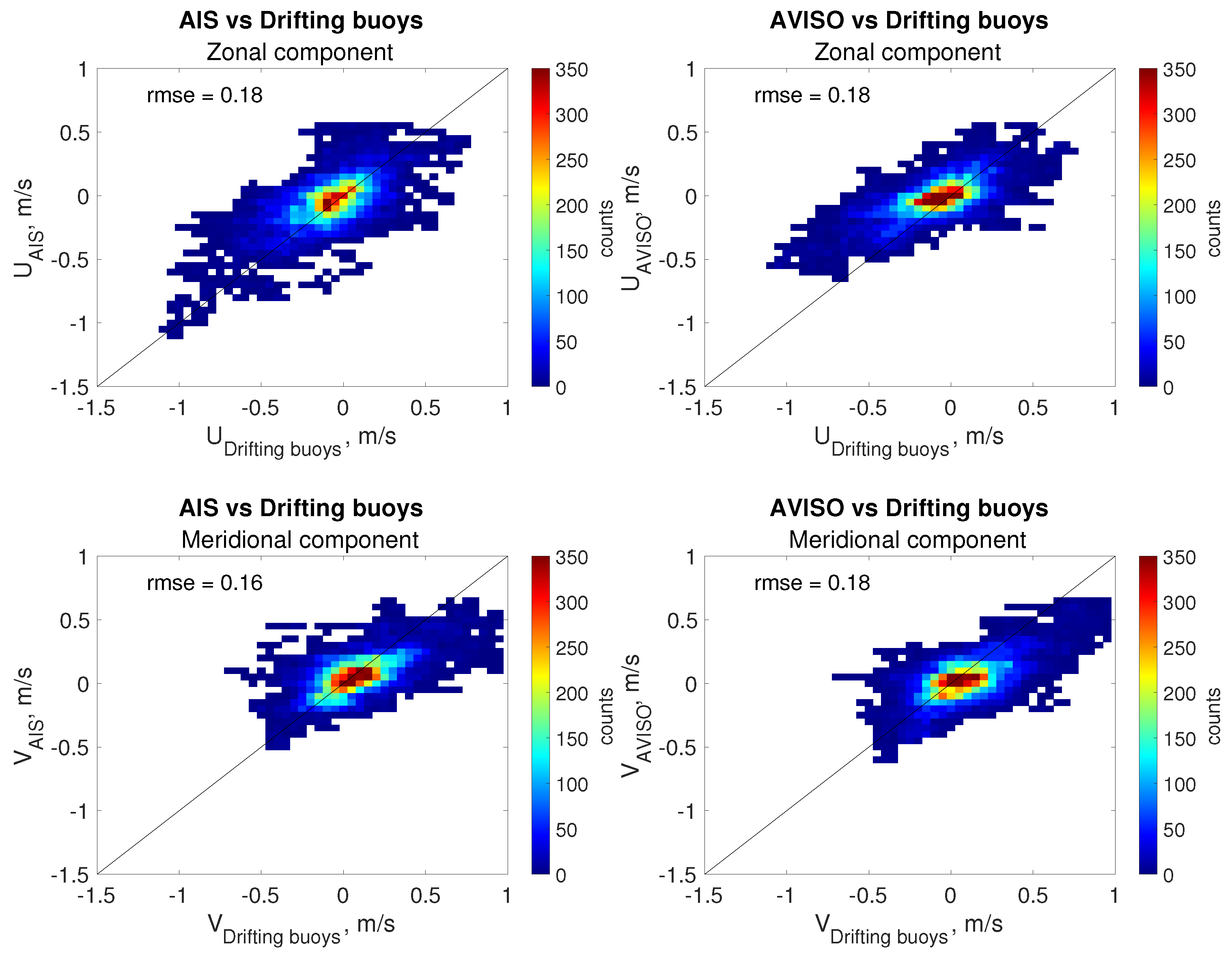

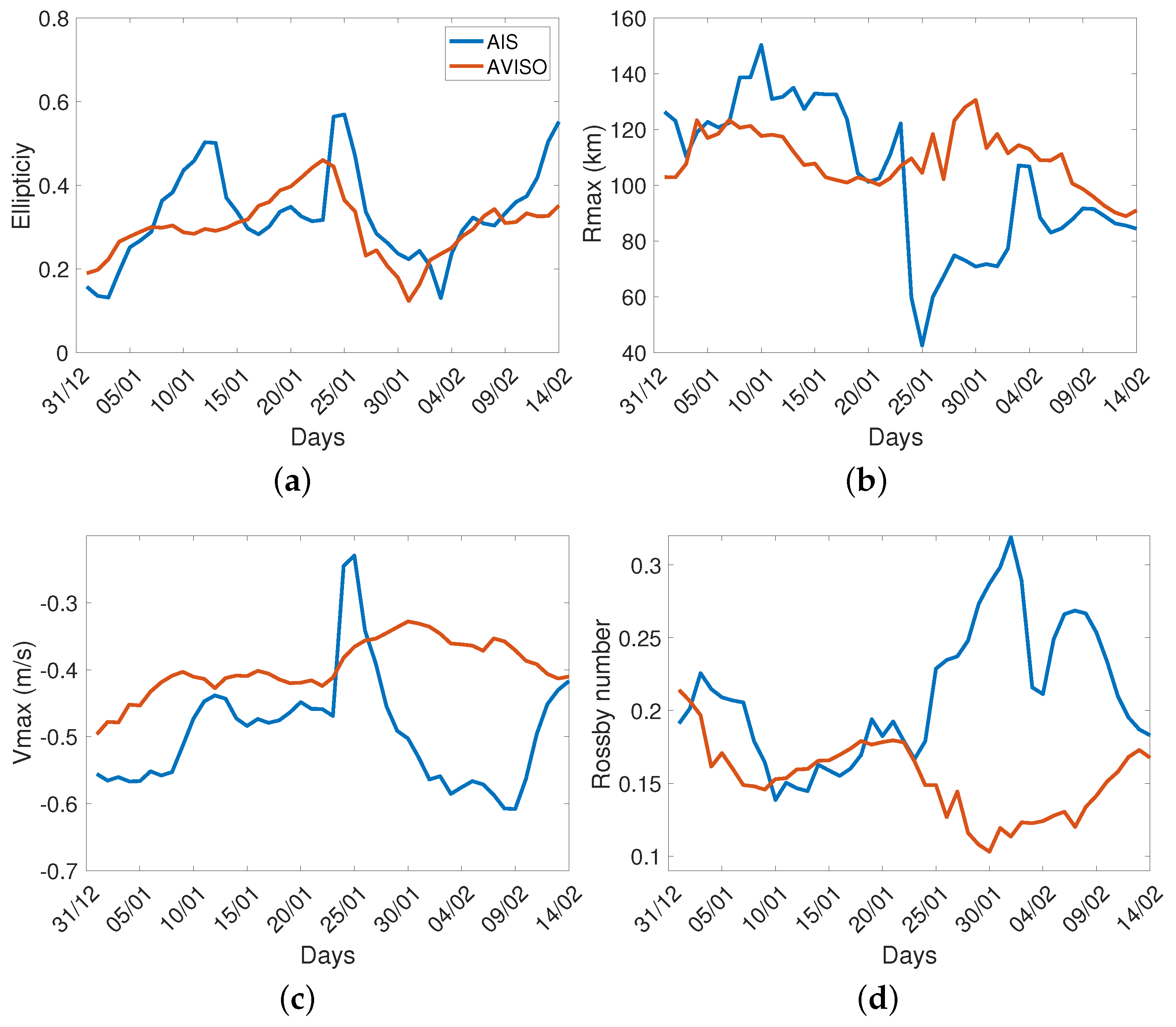
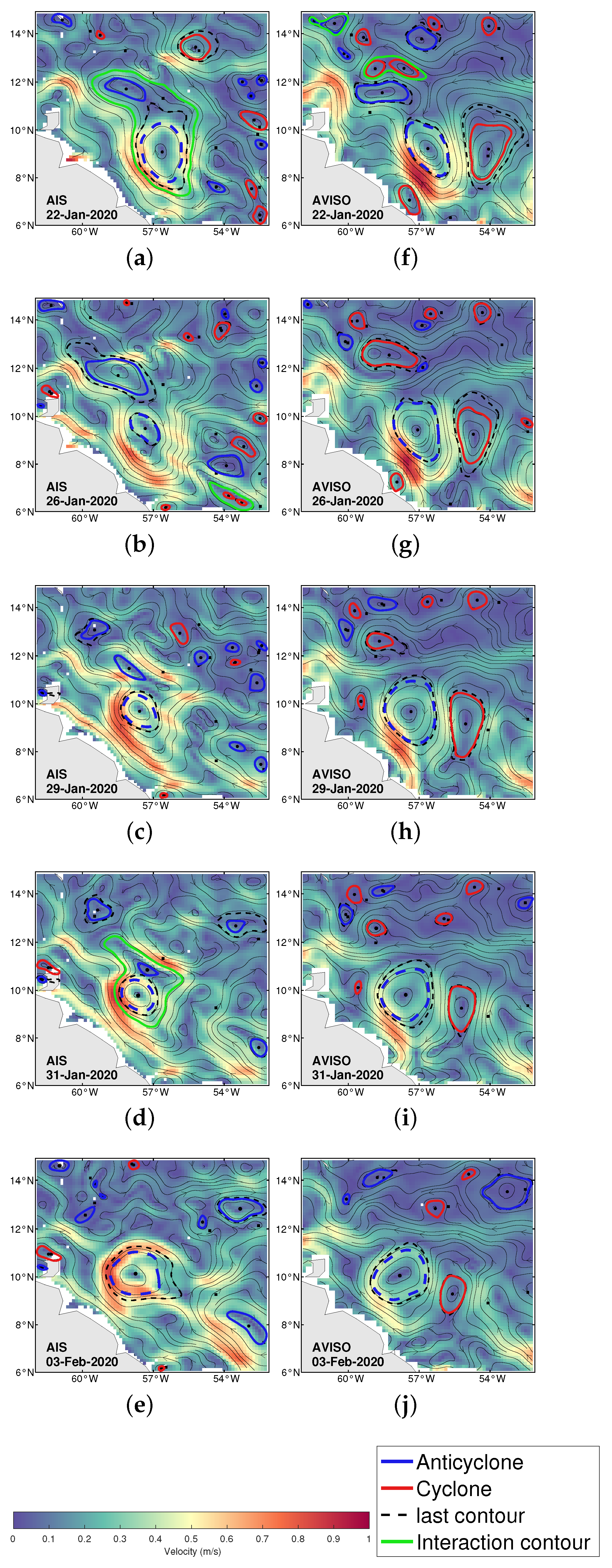
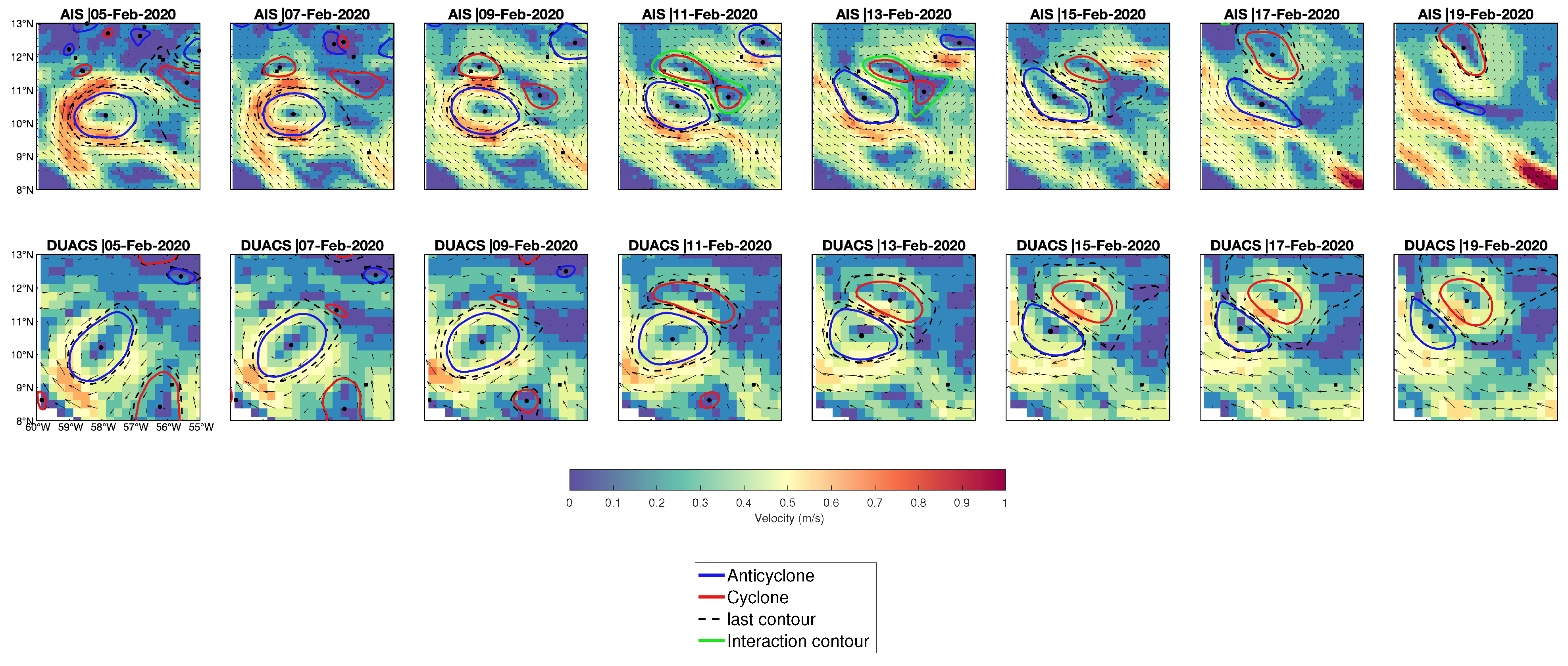
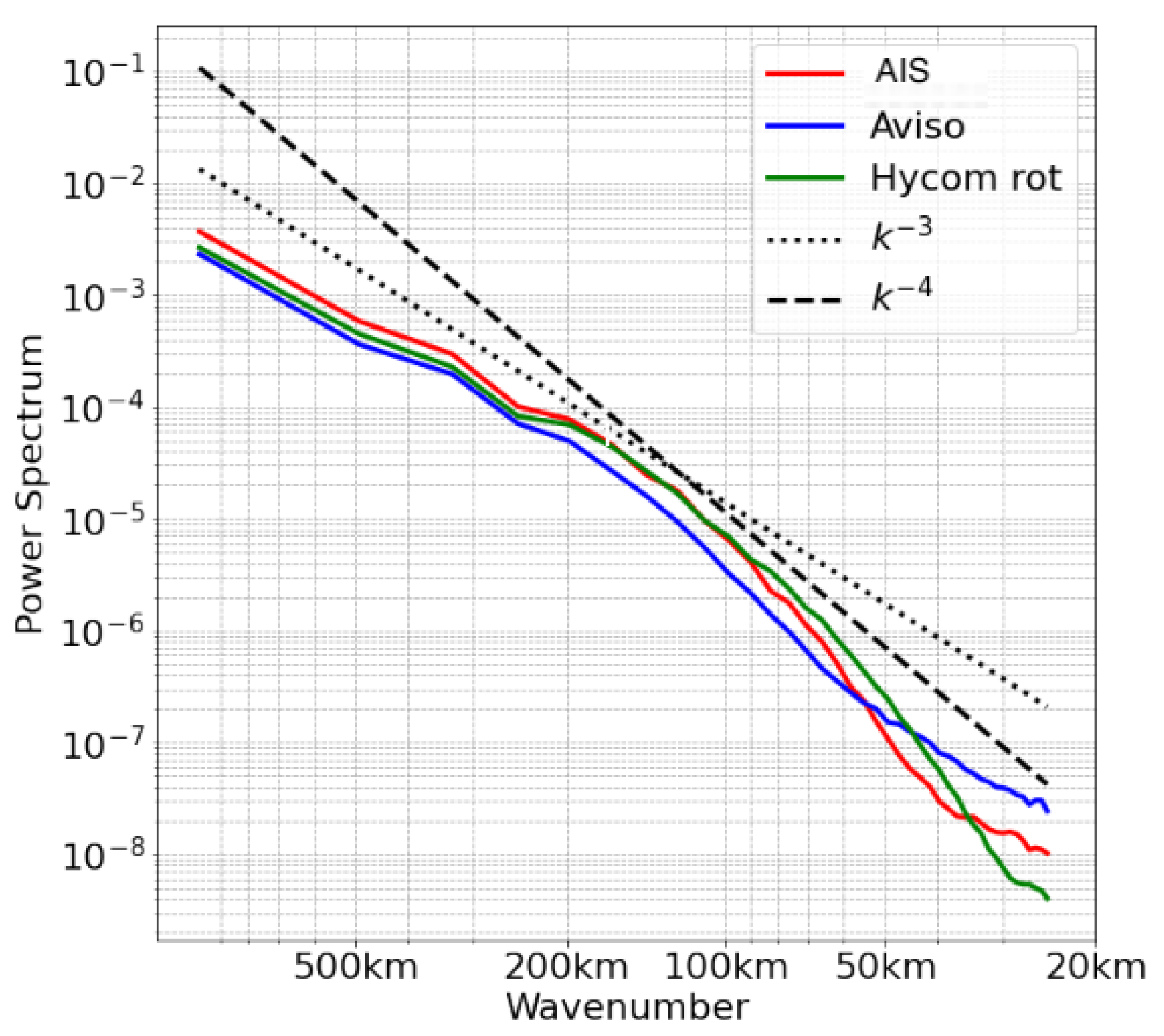
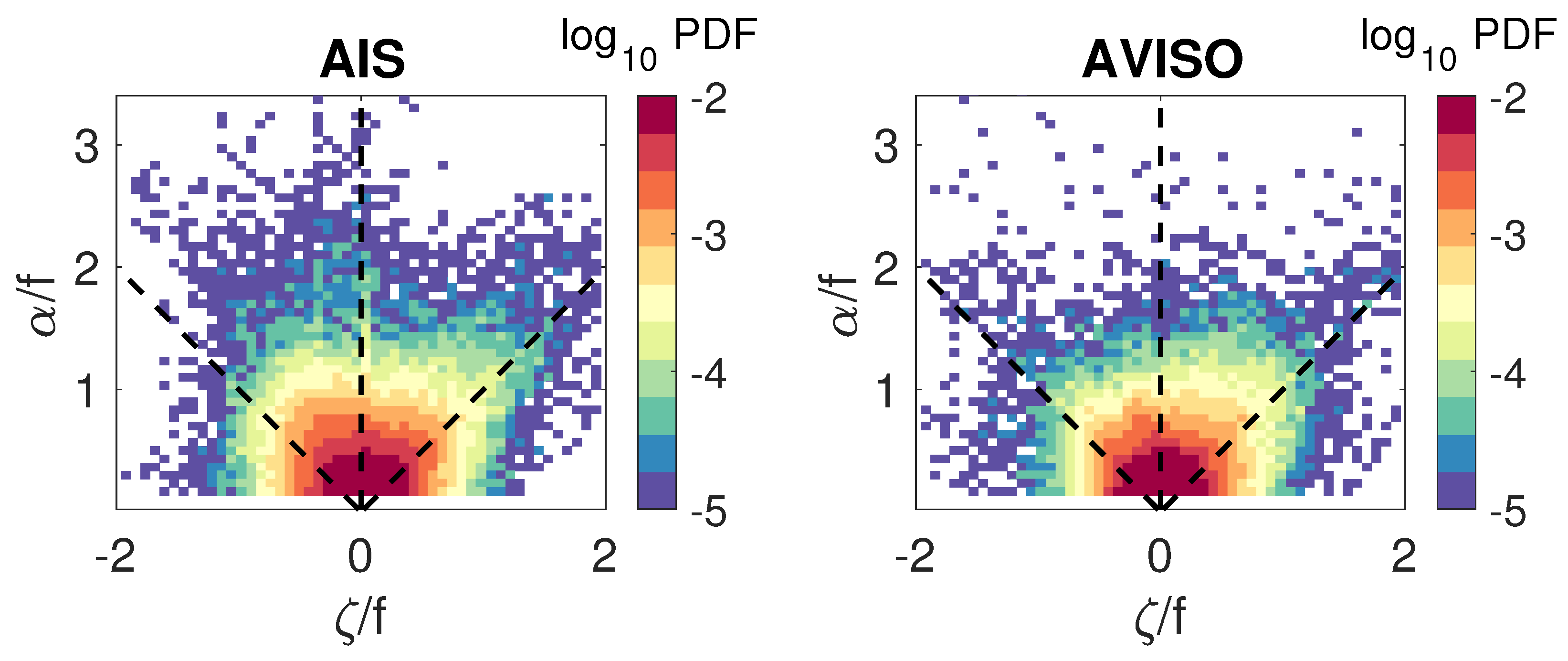
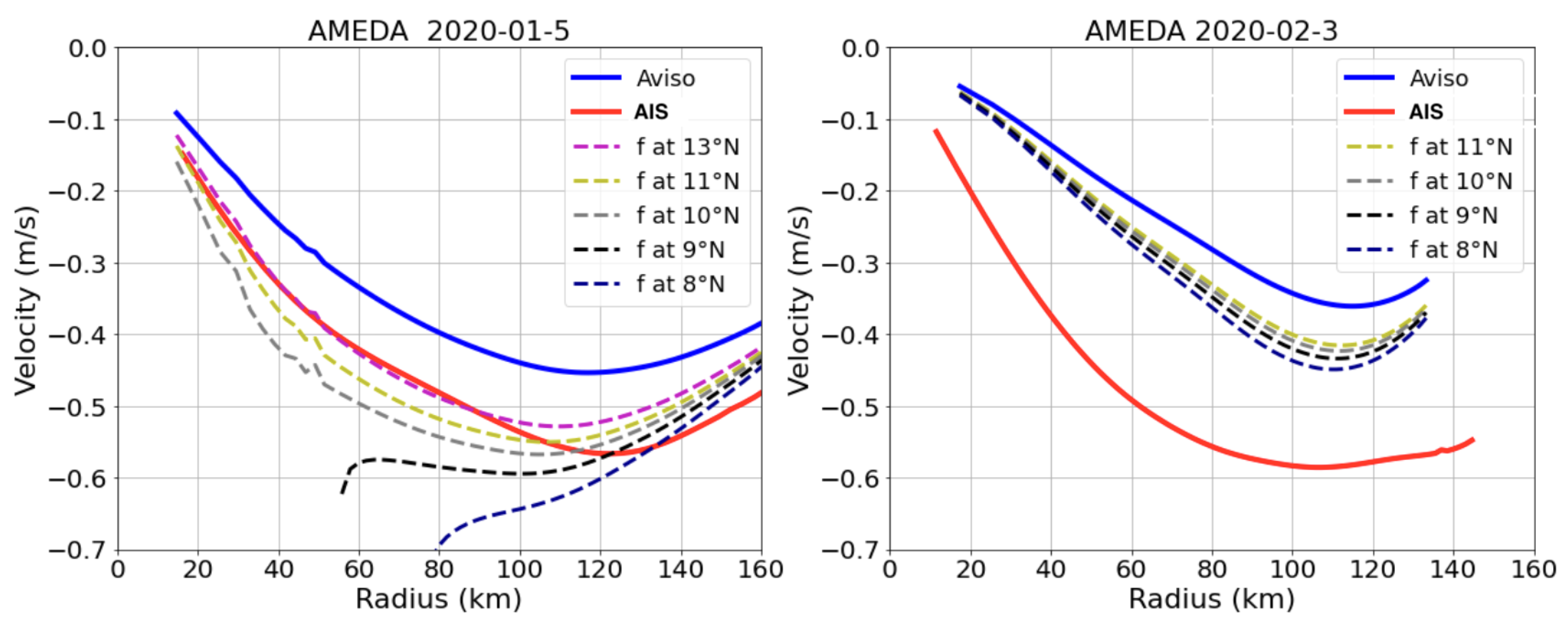
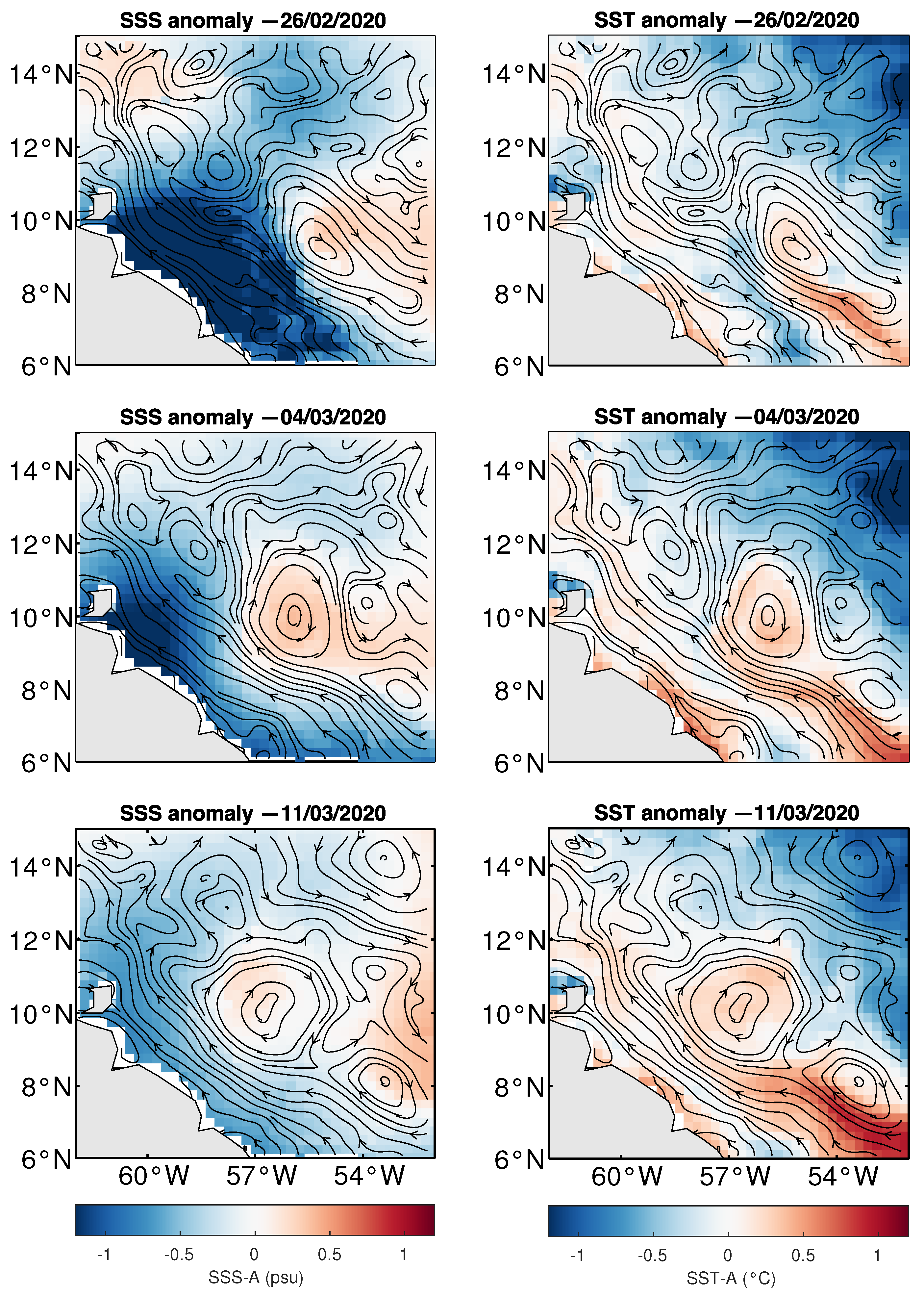
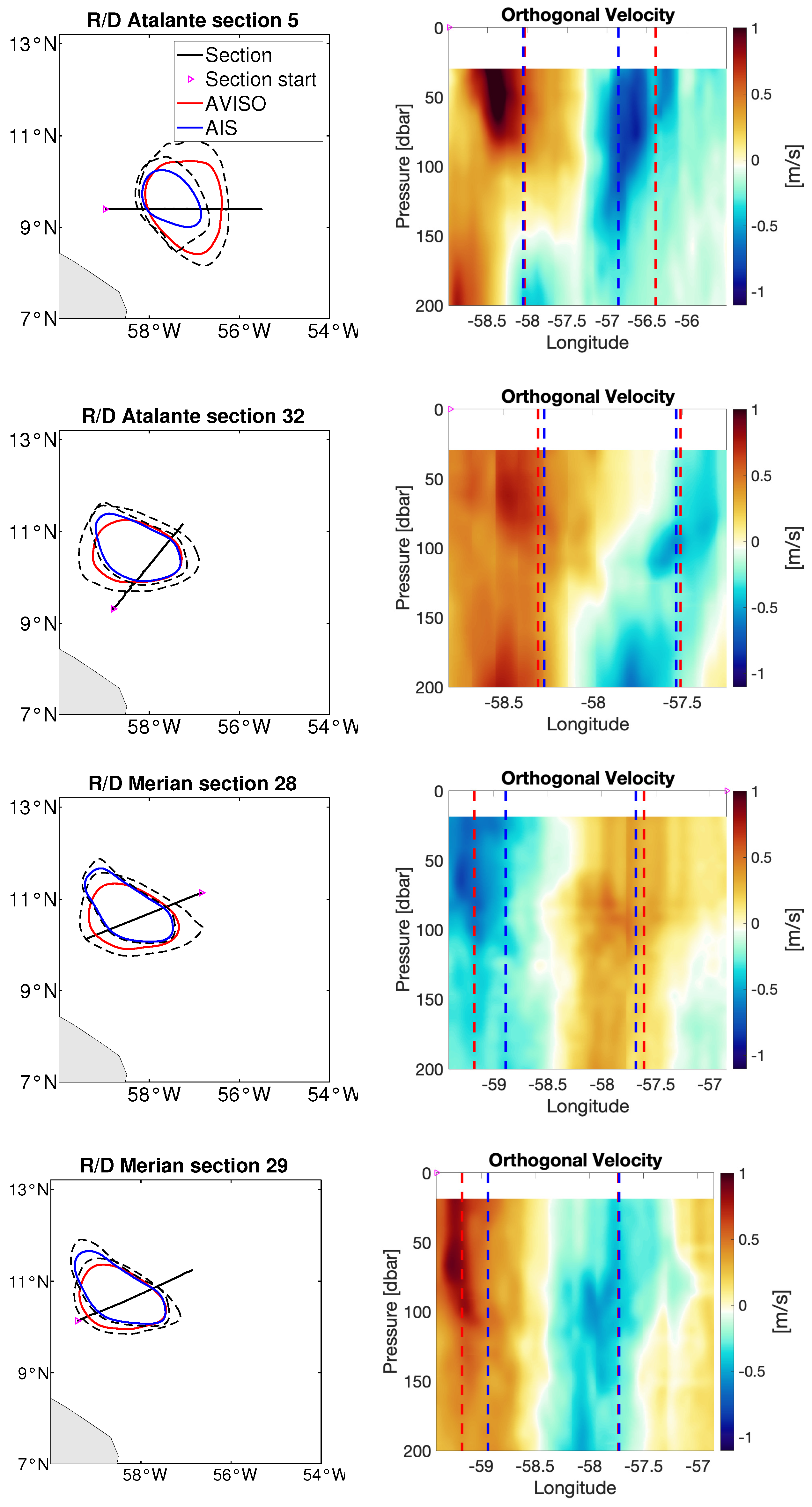
| AIS | AVISO | ||
|---|---|---|---|
| Individual eddies (snapshots) | Total | 821 | 900 |
| AE | 520 (64%) | 450 (50%) | |
| CE | 301 (36%) | 450 (50%) | |
| Trajectories (dynamic view) | Total | 48 | 43 |
| AE | 25 (52%) | 20 (46%) | |
| CE | 23 (48%) | 23 (55%) | |
| Par | AIS | AVISO | Historical Values |
|---|---|---|---|
| Ts | 0.18 m/s | 0.14 m/s | 0.15, 0.16, 0.15, 0.16, 0.15, 0.14, 0.17, 0.17 m/s [6,7,11,12,13,14,15,17] |
| Rmax | 102 km | 110 km | 124 km, 140, 140 km [12,16,17] |
| Vmax | 0.5 m/s | 0.4 m/s | 0.45, 0.4, 0.8, 0.42, 1, 0.75, 0.9, 0.37, and 0.40 [2,4,5,8,11,12,16,17,18] |
| Ro | 0.20 | 0.15 | 0.17, 0.08, [0.12 and 0.26], 0.33 [5,8,12,16] |
Disclaimer/Publisher’s Note: The statements, opinions and data contained in all publications are solely those of the individual author(s) and contributor(s) and not of MDPI and/or the editor(s). MDPI and/or the editor(s) disclaim responsibility for any injury to people or property resulting from any ideas, methods, instructions or products referred to in the content. |
© 2024 by the authors. Licensee MDPI, Basel, Switzerland. This article is an open access article distributed under the terms and conditions of the Creative Commons Attribution (CC BY) license (https://creativecommons.org/licenses/by/4.0/).
Share and Cite
Boussidi, B.; Le Goff, C.; Galard, C.; Carton, X.; Speich, S. The Analysis of North Brazil Current Rings from Automatic Identification System Data and Altimetric Currents. Remote Sens. 2024, 16, 2828. https://doi.org/10.3390/rs16152828
Boussidi B, Le Goff C, Galard C, Carton X, Speich S. The Analysis of North Brazil Current Rings from Automatic Identification System Data and Altimetric Currents. Remote Sensing. 2024; 16(15):2828. https://doi.org/10.3390/rs16152828
Chicago/Turabian StyleBoussidi, Brahim, Clément Le Goff, Corentin Galard, Xavier Carton, and Sabrina Speich. 2024. "The Analysis of North Brazil Current Rings from Automatic Identification System Data and Altimetric Currents" Remote Sensing 16, no. 15: 2828. https://doi.org/10.3390/rs16152828






